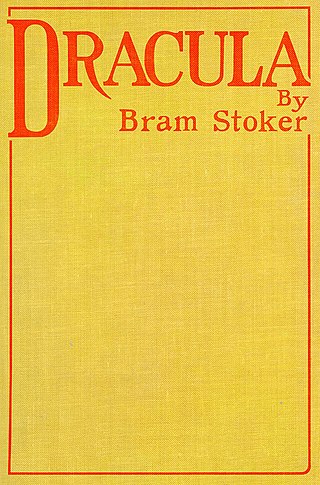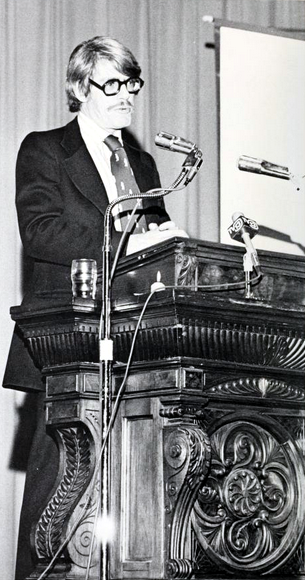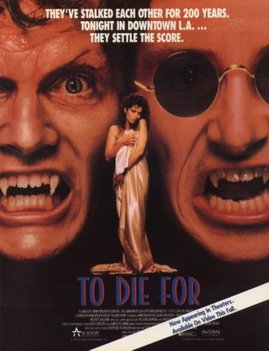
Abraham "Bram" Stoker was an Irish author who is best known for writing the 1897 Gothic horror novel Dracula. During his lifetime, he was better known as the personal assistant of actor Sir Henry Irving and business manager of the West End's Lyceum Theatre, which Irving owned.

Dracula is a 1897 Gothic horror novel by Irish author Bram Stoker. An epistolary novel and a classic of English literature, the narrative is related through letters, diary entries, and newspaper articles. It has no single protagonist and opens with solicitor Jonathan Harker taking a business trip to stay at the castle of a Transylvanian nobleman, Count Dracula. Harker escapes the castle after discovering that Dracula is a vampire, and the Count moves to England and plagues the seaside town of Whitby. A small group, led by Abraham Van Helsing, investigate, hunt, and kill Dracula.

Vampire literature covers the spectrum of literary work concerned principally with the subject of vampires. The literary vampire first appeared in 18th-century poetry, before becoming one of the stock figures of gothic fiction with the publication of Polidori's The Vampyre (1819), inspired by a story told to him by Lord Byron. Later influential works include the penny dreadful Varney the Vampire (1847); Sheridan Le Fanu's tale of a lesbian vampire, Carmilla (1872), and the most well known: Bram Stoker's Dracula (1897). Some authors created a more "sympathetic vampire", with Varney being the first, and more recent examples such as Moto Hagio's series The Poe Clan (1972–1976) and Anne Rice's novel Interview with the Vampire (1976) proving influential.

Bram Stoker's Dracula is a 1992 American gothic horror film produced and directed by Francis Ford Coppola and written by James V. Hart, based on the 1897 novel Dracula by Bram Stoker. The film stars Gary Oldman, Winona Ryder, Anthony Hopkins, and Keanu Reeves, with Richard E. Grant, Cary Elwes, Billy Campbell, Sadie Frost, and Tom Waits in supporting roles. Set in 19th-century England and Romania, it follows the eponymous vampire (Oldman), who falls in love with Mina Murray (Ryder), the fiancée of his solicitor Jonathan Harker (Reeves). When Dracula begins terrorizing Mina's friends, Professor Abraham Van Helsing (Hopkins), an expert in vampirism, is summoned to bring an end to his reign of terror. Its closing credits theme "Love Song for a Vampire", was written and performed by Annie Lennox.

Vlad III, commonly known as Vlad the Impaler or Vlad Dracula, was Voivode of Wallachia three times between 1448 and his death in 1476/77. He is often considered one of the most important rulers in Wallachian history and a national hero of Romania.

Radu Florescu was a Romanian academic who held the position of Emeritus Professor of History at Boston College. His work on Vlad Dracula includes a series of bestselling books that he co-authored with his colleague Raymond T. McNally. Along with serving as Director of the East European Research Center at Boston College, Florescu was also a philanthropist and an adviser to Edward Kennedy on Balkan and Eastern European affairs. At the time of his death, Radu Florescu was considered the patriarch of the Florescu family.

Vampire films have been a staple in world cinema since the era of silent films, so much so that the depiction of vampires in popular culture is strongly based upon their depiction in films throughout the years. The most popular cinematic adaptation of vampire fiction has been from Bram Stoker's 1897 novel Dracula, with over 170 versions to date. Running a distant second are adaptations of the 1872 novel Carmilla by Sheridan Le Fanu.
"Buffy vs. Dracula" is the season 5 premiere of the television series Buffy the Vampire Slayer. The episode aired on September 26, 2000 on The WB.
Rudolf Martin is a German actor working mainly in the United States. He first appeared in off-Broadway productions and then moved on to extensive TV and film work. He has made guest appearances on numerous hit television series and recently started working in Germany as well. He currently resides in Los Angeles.

To Die For is a 1989 American independent romantic horror film directed by Deran Sarafian and starring Brendan Hughes as vampire Vlad Tepes, Duane Jones, Philip Granger, Julie Maddalena and Amanda Wyss.
Abhartach, also Avartagh, is an early Irish legend, which was first collected in Patrick Weston Joyce's The Origin and History of Irish Names of Places (1870). Abhartach should not be confused with the similarly named Abartach, a figure associated with Fionn mac Cumhaill.

Count Dracula is the title character of Bram Stoker's 1897 gothic horror novel Dracula. He is considered the prototypical and archetypal vampire in subsequent works of fiction. Aspects of the character are believed by some to have been inspired by the 15th-century Wallachian prince Vlad the Impaler, who was also known as Vlad Dracula, and by Sir Henry Irving and Jacques Damala, actors with aristocratic backgrounds that Stoker had met during his life.

Dracula, also known as Bram Stoker's Dracula and Dan Curtis' Dracula, is a 1974 British made-for-television gothic horror film and adaptation of Bram Stoker's 1897 novel Dracula. It was written by Richard Matheson and directed by Dark Shadows creator Dan Curtis, with Jack Palance in the title role. It was the second collaboration for Curtis and Palance after the 1968 TV film The Strange Case of Dr. Jekyll and Mr. Hyde.

The character of Count Dracula from the 1897 novel Dracula by Bram Stoker, has remained popular over the years, and many forms of media have adopted the character in various forms. In their book Dracula in Visual Media, authors John Edgar Browning and Caroline Joan S. Picart declared that no other horror character or vampire has been emulated more times than Count Dracula. Most variations of Dracula across film, comics, television and documentaries predominantly explore the character of Dracula as he was first portrayed in film, with only a few adapting Stoker's original narrative more closely. These including borrowing the look of Count Dracula in both the Universal's series of Dracula and Hammer's series of Dracula, including the character's clothing, mannerisms, physical features, hair style and his motivations such as wanting to be in a home away from Europe.
Raymond T. McNally (1931–2002) was an American author and a professor of Russian and East European History at Boston College. He specialized in the history of horror and wrote many books on the subject. He co-authored several books with Radu Florescu (1925–2014), who was also a professor at Boston College.

Bram Stoker's Dracula's Curse is a 2006 horror film by The Asylum, written and directed by Leigh Scott. Despite featuring Bram Stoker's name in the title, the film is not directly based on any of his writings or a mockbuster to the 1992 film Bram Stoker's Dracula, but shares similarities to films such as Blade: Trinity, Dracula 2000, Underworld: Evolution and Van Helsing. The film also shares some similarities with the 1971 Hammer horror film Countess Dracula, which also features a Dracula-esque femme fatale in the lead role.

Dracula the Un-dead is a 2009 sequel to Bram Stoker's classic 1897 novel Dracula. The book was written by Bram Stoker's great-grandnephew Dacre Stoker and Ian Holt. Previously, Holt had been a direct-to-DVD horror screenwriter, and Stoker a track and field coach.

Dracula tourism is a type of cultural tourism involving travel to sites associated with Dracula and his real or imaginary travels. There is Dracula tourism mainly in Transylvania, Romania.

Dracula Untold is a 2014 American action horror film directed by Gary Shore in his feature film debut and written by Matt Sazama and Burk Sharpless. The plot creates an origin story for the title character, rather than using the storyline of Bram Stoker's 1897 novel. In this adaptation, Dracula is the historical figure Vlad III "the Impaler" Dracula and transforms into his monstrous alter ego to protect his family and kingdom from Ottoman Sultan Mehmed II. Luke Evans portrays the title character, with Sarah Gadon, Dominic Cooper, Art Parkinson, and Charles Dance cast in supporting roles. Principal photography began in Northern Ireland on August 5, 2013.

Dracula 5: The Blood Legacy is a 2013 point-and-click adventure video game developed by Koalabs Studio for Microsoft Windows, iOS, Android and OS X. It was published on all systems by Anuman under their Microïds brand. In 2014, the game was released on GOG.com and Steam, bundled with its prequel, Dracula 4: The Shadow of the Dragon.














